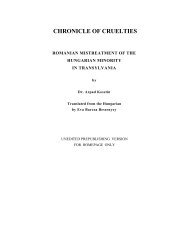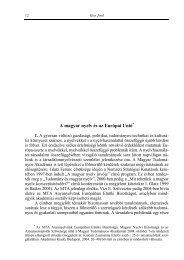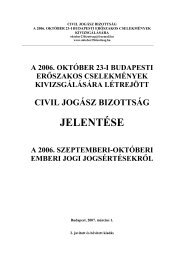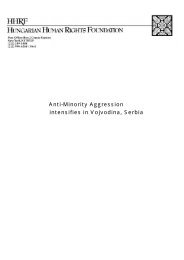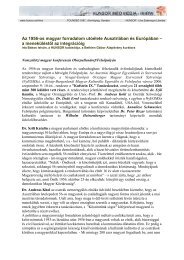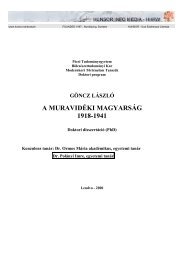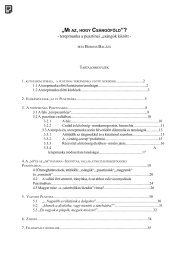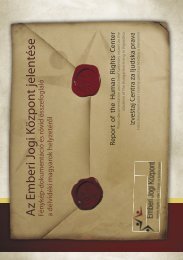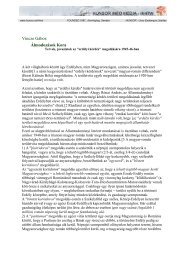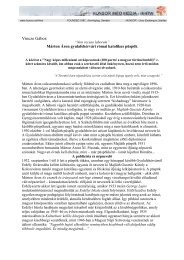PLEASE NOTE: This book contains graphic description ... - HUNSOR
PLEASE NOTE: This book contains graphic description ... - HUNSOR
PLEASE NOTE: This book contains graphic description ... - HUNSOR
Create successful ePaper yourself
Turn your PDF publications into a flip-book with our unique Google optimized e-Paper software.
were called one by one from a list, never to come back again. Their bodies were mostly taken tothe Tisza or to one of the mass graves at the carrion pit of the village. The mass graves have notbeen investigated, since there remained no Hungarian population in the village who would beready to remember and mourn.About two thousand Hungarians were executed in the village, while the rest, mostly women andchildren, were taken to a camp107in Jarek or to the more distant Gajdobra (in Hungarian Szepliget), an ethnic German villageturned into a concentration camp.Those young people who obeyed the summons, could consider themselves fortunate when theyenlisted in the Petofi Brigade. But later, it occurred to the organizer that the 65 would-be recruitswere not worthy of fighting against the German. They also ended up in Gajdobra sufferingtorments and privation.Let us take a glance at the black pages of Hungarian history with the help of a letter written by a53 year old Hungarian physician:"I was born in 1937 in Csurog and lived there until 1944. I cannot remember the exact datesnow, nor have I anyone to ask since my father died ten years ago. Although these tragedies stillaffect the whole family, we were unable to mention or talk about it until now.My father's parents were executed in 1944, in their own home in Csurog. Their names wereIstvan Balogh and Julianna Peter. The story of their execution could be told by my cousins.My father's brother, Pal Balogh, was killed brutally. I remember my parents saying that it wasannounced in the village that the executions would be the following day in front of the VillageHall. The relatives who wanted to watch it could go. The sons of my uncle live in Telecska andhave a lot to say about this. My aunt died last year. My mother's brother, Istvan Szerda was alsoexecuted brutally. On a cold wintry day in 1944, four or five armed men burst into our house andshouted at my mother (father was not at home, he was a soldier) that we should within threeminutes go out to the street. There were four of us children, my brother a babe in arms and I, theoldest was six years old. We were put on cattle-trucks the same night. I can remember a long lineof people standing in the street, all of them Hungarians. Then we were transported to the camp inJarek.We spent, if I remember correctly, nine months in the camp at Jarek. My mother said more thanhalf of the people died; people dropped like flies. The dead were carried to a carrion pit on a cart.The only food we were given was hominy unsalted. Since there was no soap and water, licewere feeding on us. We survived due to the help of our aunt, who would secretly leave the campat night to steal some carrots or potatoes from the fields.When we were able to leave the camp, we looked so bad that those in Auschwitz were fatcompared to us. We were skeletons standing there in rags, when we were told we could goanywhere except home. There were already people from the mountains of Montenegro or Bosnialiving in our house."108The partisan movement could not be stopped by the early Hungarian military actions. Thecounter-espionage organisation was still looking for the remaining or, newly infiltrated partisans



